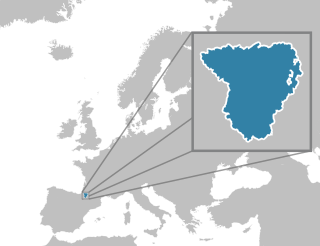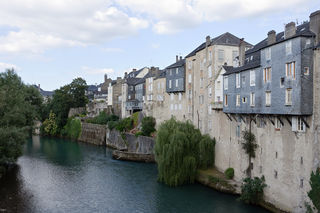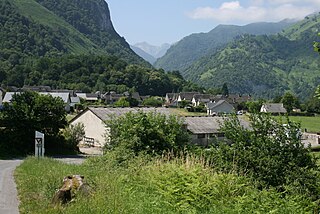
Béarn is one of the traditional provinces of France, located in the Pyrenees mountains and in the plain at their feet, in Southwestern France. Along with the three Basque provinces of Soule, Lower Navarre and Labourd, the Principality of Bidache, as well as small parts of Gascony, it forms the current Pyrénées-Atlantiques department. The capitals of Béarn were successively Beneharnum, Morlaàs, Orthez and then Pau.

Oloron-Sainte-Marie is a commune in the southwestern French department of Pyrénées-Atlantiques.

The arrondissement of Oloron-Sainte-Marie is an arrondissement of France in the Pyrénées-Atlantiques department in the Nouvelle-Aquitaine region. It has 155 communes. Its population is 72,504 (2016), and its area is 2,828.2 km2 (1,092.0 sq mi).

Jean Lassalle is a French politician who represented the 4th constituency of the Pyrénées-Atlantiques department in the National Assembly from 2002 to 2022. A former member of the Democratic Movement (MoDem), he was a candidate in the 2017 presidential election, in which he received 435,301 votes (1.21%). Lassalle ran under the banner of Résistons! (RES), a party he founded and has led since he left the MoDem in 2016. In the 2022 presidential election he received 1.3 million votes constituting over 3% of those cast.

Canfranc is a municipality in the Aragón Valley of north-eastern Spain consisting of two villages, the original village and Canfranc Estación, which developed with the establishment of Canfranc International railway station to serve railway traffic across the Pyrenees.

The A65 autoroute is a motorway in south west France. Construction started in 2008 and it was officially opened on 14 December 2010. It connects Langon (Gironde) to Pau (Pyrénées-Atlantiques), with a toll payable of €19.70 for the complete journey by car.

The Gave d'Ossau is the torrential river flowing through the Ossau Valley, one of the three main valleys of the High-Béarn (Pyrénées-Atlantiques), in the Southwest of France.

The Gave d'Aspe is a torrential river flowing through the Aspe Valley, one of the three main valleys of the High-Béarn (Pyrénées-Atlantiques), in the southwest of France. It is 58.1 km (36.1 mi) long.

Asasp-Arros is a commune in the Pyrénées-Atlantiques department in the Nouvelle-Aquitaine region of south-western France.

Arudy is a commune in the Pyrénées-Atlantiques department in the Nouvelle-Aquitaine region of south-western France.

Arette is a commune in the Pyrénées-Atlantiques department in the Nouvelle-Aquitaine region of southwestern France. It is located in the arrondissement of Oloron-Sainte-Marie and the canton of Oloron-Sainte-Marie-1.

Agnos is a commune in the Pyrénées-Atlantiques department in the Nouvelle-Aquitaine region in southwestern France. Agnos is part of the urban area of Oloron-Sainte-Marie.

Accous is a commune in the Pyrénées-Atlantiques department in the Nouvelle-Aquitaine region in southwestern France.

Aspe peak is a mountain in the western Pyrenees of Huesca; which is situated on the west side of the Aragon Valley near the towns of Villanúa and Canfranc. The peak is 2,645 metres (8,678 ft) AMSL high. It is adjoined to the peak of Zapatilla.

European route E7 forms part of the international E-road network. It runs between Langon in France and Zaragoza in Spain.

Canfranc International railway station is a formerly international railway station in the village of Canfranc in the Spanish Pyrenees. The Somport railway tunnel, inoperative since 1970, which carries the Pau–Canfranc railway, under the Pyrenees into France, is located at its northern end.

The Fort du Portalet is a fort in the Aspe Valley in Bearn, French Pyrenees, built from 1842 to 1870.

The Pau–Canfranc railway is a partially-closed 93 km (58 mi) long international single-track standard gauge railway line connecting Pau in the Pyrénées-Atlantiques region of France, climbing via the Gave d'Aspe valley and tunneling under the Pyrenees, to Canfranc in Spain. The line is part of transport infrastructure between Bordeaux and Zaragoza and is now named the Goya Line, after the painter Francisco de Goya who was born near Zaragoza and died in Bordeaux.
The Aspe Valley is a valley in the French part of the Pyrenees, department of Pyrénées-Atlantiques.
The canton of Oloron-Sainte-Marie-1 is an administrative division of the Pyrénées-Atlantiques department, southwestern France. It was created at the French canton reorganisation which came into effect in March 2015. Its seat is in Oloron-Sainte-Marie.



















